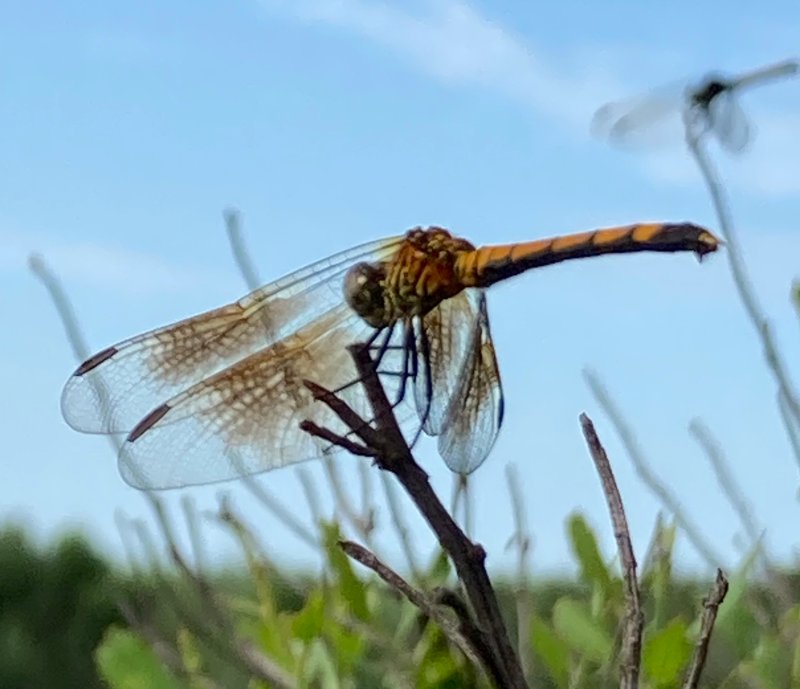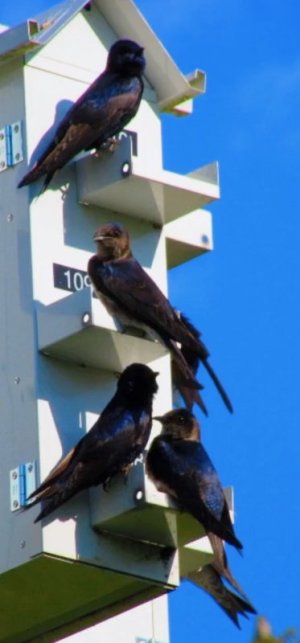Dragonfly and Purple Martin take flight over salt marsh
If I’m not in the mud of the salt marsh, the next best thing is walking the Gordons Pond Trail. Peaking between the pale green, toothed leaves of the Groundseltree (Baccharis halimifolia) to the distant salt pond, I sight a regal Snowy Egret perched on a driftwood sculpture. Satisfied, I plan to move forward when I sense a vibration of activity. No binoculars needed.
An air column of winged acrobats, reminiscent of a three-ring circus with daring feats of flight from floor to ceiling, are airborne at different altitudes. For a moment in time, this awesome show is contained in a 10-foot wide space. Closest to the marsh edge, hundreds of colorful dragonflies called Seaside Dragonlets (Erythrodiplax berenice) perch and launch, while Tree Swallows (Tachycineta bicolor) circle above with a collective bubbling sound and iridescent Purple Martins (Progne subis) swoop and glide under a mackerel sky. Each species is an aerial insectivore, a flying daredevil that spins, twists and turns, “hawking,” or pursuing winged insects for food.
My experience watching this two-story slice of arial ecology provides days of thoughts and questions with rewarding connections. Specific weather conditions, such as atmospheric pressure, humidity, solar radiation and wind contribute to the concentration of available flying insects at any given time. What conditions create an ideal opportunity for insects or birds to feed on the wing? How do these local species find these spaces?
The only saltwater breeder in North America, Seaside Dragonlets emerge from aquatic larvae in large numbers and occupy every branch top along the marsh edge. Look for the amber wing patch and striking orange/yellow and black diamond pattern on the abdomen characteristic of the females; while territorial males have clear wings with a blue-black abdomen. Sentinels and watchful pilots jump from branch to branch with flights upward to snatch deer flies, mosquitoes and midges (often a whirling group of small insects) out of the air. Throughout the summer, there is a constant turnover of Seaside Dragonlets as new dragonflies emerge and the older ones complete their life cycle.
In the upper reaches of this altitude band, Purple Martins are the largest members of the swallow family in North America. They occupy a distinct air space, circling while maintaining height with a flap, flap, flap glide above the smaller Tree Swallows (also circling). Looking up, male martins are distinguished by their glossy purple breast feathers, while females and juveniles are mottled brown and white underneath. Purple Martins are colony nesters and dependent on man-made structures like gourds and houses, which dot our landscape in the Cape Region. A typical nest contains four to six hatchlings which need constant and consistent feeding during daylight hours. As Purple Martins are opportunistic feeders, any aerial insect is fair game. In her thesis, Identifying Purple Martin Diet and Its Effect on Nestling Development, Claire Bernard (University of Delaware, 2024) was able to identify the types of insects parents were feeding their chicks. Her research found that the martin colony with the heaviest (a good thing) offspring had the highest proportion of aquatic flies in their diet. Aquatic flies, like deer and horse flies, begin their development as eggs, then larvae in water.
In the shallow salt ponds in our marsh, marine microalgae naturally synthesizes DHA and EPA which are the richest source of Omega-3 fatty acids. Over an 11-month period, a Seaside Dragonlet larva consumes marine microalgae and preys on smaller aquatic insect larvae (that feed on marine microalgae). Seaside Dragonlets emerge as adults rich in protein and Omega-3 fatty acids! Just amazing. Imagine the health benefits for consumers. Omega-3 fatty acids are essential nutrients that you need to get from the foods you eat. The Tree Swallows and Purple Martins in the temporary air column, finding the right conditions at the right time, may have seized the moment to outmaneuver and eat a Seaside Dragonlet or two.
As August days draw closer to September, large numbers of martins will gather on wires along Lighthouse Road, Prime Hook Road and Oyster Rocks Road to rest and feed, gliding with beaks wide open, a graceful feeding frenzy to fuel their mass migration to points south of the Amazon Rainforest. According to the Purple Martin Conservation Association website at purplemartin.org, fall migration is not a rushed process, it includes extended layovers and does not follow the spring migration route. Perhaps they are following our east coast marshes to the gulf feeding on nutrient rich Seaside Dragonlets. Food for thought.

























































